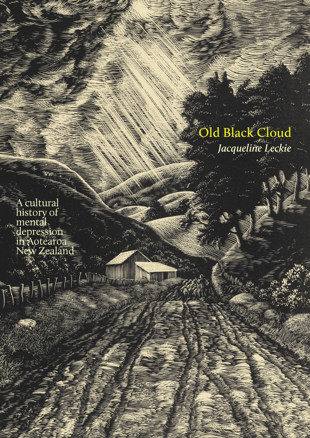Solomon Lewis reviews Old Black Cloud: A cultural history of mental depression in Aotearoa New Zealand by Jacqueline Leckie for North & South:
‘Old Black Cloud: A cultural history of mental depression in Aotearoa New Zealand, draws our attention to depression and its place in New Zealand culture. Jacqueline Leckie incorporates a wide variety of sources, both medical and cultural, that are woven together by her strong sense or historical narrative. Patient records and superintendent reports from the asylums that once housed the "insane" are included alongside literature, poetry, documentary photography and visual art, such as the striking E. Mervyn Taylor woodcut that adorns the book's cover. The result is an account of depression in New Zealand that is at once academically authoritative and poetically resonant.
Of particular interest are her chapters on melancholia in early colonial times and her inquiry into depression and its correlates in Māori culture. Leckie opens her chapter on the early colonial era, "Lonely Land", with a quote from Dr Morgan Stanislaus Grace's Report of the Joint Committee on Lunatic Asylums, 1871, that speaks to the alienating effect a long sea voyage to an unfamiliar land had on many early migrants. "Insanity is much more common in this country than it is at home, chiefly on account of the limited range of sympathy which it gives rise to, and also on account of the oppressive loneliness which many newcomers experience even in our crowded towns."
The chapter proceeds with the harrowing story of working-class Irish woman Julia Rowan, who, like so many others, ventured to New Zealand with her husband Thomas, looking to escape poverty and lack of class mobility in the Old World. Soon after arrival, Thomas was seriously injured and unceremoniously lost his job. Julia found herself living in a tent in Pūrākanui, Otago, with five children while her husband ventured north to find work. Physically emaciated from caring for five children in harsh conditions, she was committed to Dunedin Lunatic Asylum and diagnosed with melancholia. Much improved after seven weeks, due to receiving regular meals so much as any medical intervention per se, she was released and took up residence in the Benevolent Institution in Caversham, Dunedin. Julia would be in and out of asylums for much of her life, her children taken from her and sent to Caversham's Industrial school, with her husband Thomas ultimately dying in another Dunedin-based asylum. Sadly, this tragic tale is not the exception. The rest of the chapter details many similar accounts of unfortunate souls who, upon arriving in the antipodes, found not brighter shores but rather darkness, misery and ruin.
"Rāwakiwaki", Leckie's chapter on depression in Māori culture, is similarly compelling in its examination of the question of whether or not the concept of depression can meaningfully be applied in Māori experience prior to colonisation. Here, Leckie refers to the work of Māori studies scholars and Māori mental health practitioners, such as the eminent Dr. Mason Durie, to explore the various Māori terms and concepts traditionally used to refer to states and experiences that we would now term depression, such as rāwakiwaki, hākerekere and āhua pōuri.
Leckie explores the social and ethical dimensions of pre-colonial Māori conceptions of mental and spiritual illness through the relevance and function of concepts such as tapu and mākutu and their relationship to both individual and community health. As Durie puts it, wairangi and pōrangi (madness) were usually understood as, "An infringement of the laws of tapu or of the sensitivities of powerful others whose retaliation could produce derangement even without a physical confrontation. Although there was a spiritual basis to the condition it was also closely linked with accepted social values and often suggested a departure from community norms either by the patient or the wider community."
Throughout the chapter, Leckie also discusses how the ongoing impacts of colonisation — such as the loss of connection to whenua, whanau and whakapapa, and the social and economic inequality and the dispossession of land and culture has produced — influence the Māori experience of depression. Following Durie and the others, Leckie foregrounds the entwinement of physical, spiritual, community and mental factors, and the way that, as Durie puts it, "the foundations for mental health are [ultimately] to be found as much outside the mind and body as within."
Old Black Cloud is authoritative, erudite, and highly readable. It should be mandatory reading for all those interested in the social and cultural dimensions of depression and mental health in Aotearoa New Zealand. It is not only an essential contribution to mental health discourse in New Zealand, but in the depth of its primary research and attention and sympathy to the particularities of our local context, it represents a vital contribution to literature on depression at large.’


